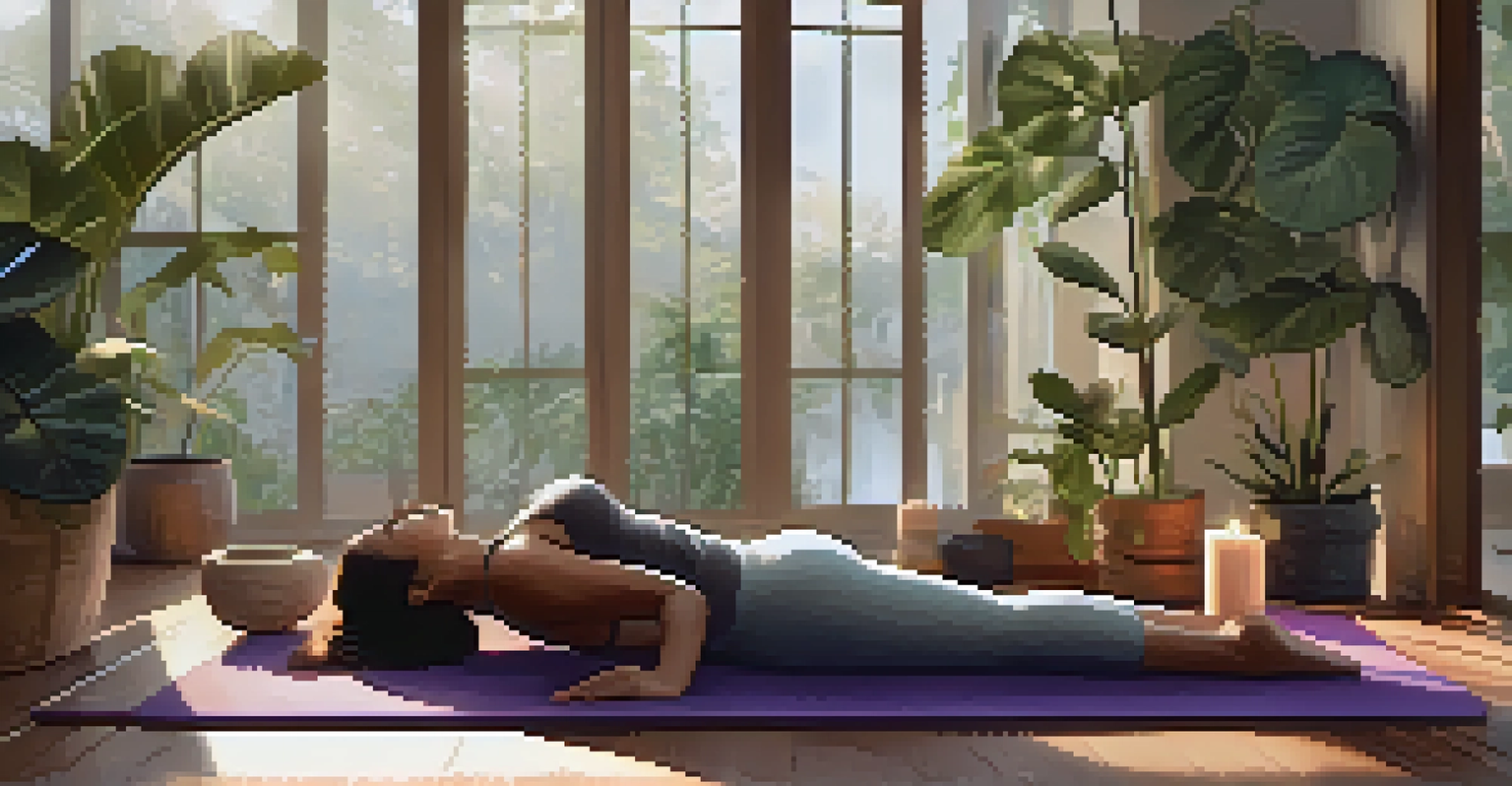Using Restorative Yoga to Combat Sleep Disorders Effectively

Understanding Sleep Disorders: A Common Challenge
Sleep disorders, such as insomnia and sleep apnea, are becoming increasingly common in today's fast-paced world. These conditions not only disrupt our nightly rest but can also lead to long-term health issues, including anxiety and depression. Understanding the roots of sleep disorders is crucial for finding effective solutions that promote restorative sleep.
Sleep is the best meditation.
Many people struggle with sleep due to stress, anxiety, or lifestyle choices, leading to a vicious cycle of sleeplessness. This can create a sense of frustration and helplessness, making it difficult to find a path to better sleep. It’s essential to approach this issue holistically, considering both mind and body.
This is where restorative yoga comes into play. By focusing on gentle stretches and deep relaxation, restorative yoga can help ease the mind and body, providing a natural remedy for those struggling with sleep disorders.
The Basics of Restorative Yoga Explained
Restorative yoga is a gentle, meditative practice designed to relax the body deeply. It utilizes props like blankets, bolsters, and straps to support the body in various poses, allowing for complete relaxation. Unlike more vigorous yoga styles, restorative yoga encourages stillness, giving you the space to breathe and let go.

In a typical restorative yoga session, poses are held for an extended period, often 5 minutes or more, to promote relaxation and release tension. This approach allows your body to enter a state of rest, which can be particularly beneficial for those suffering from sleep disorders. The focus is on creating a calming environment that invites tranquility.
Sleep Disorders Are Widespread
Conditions like insomnia and sleep apnea are increasingly common and can have significant impacts on mental health.
This practice not only helps in physical relaxation but also calms the mind, making it easier to transition into sleep. By incorporating restorative yoga into your routine, you can cultivate a sense of peace that is essential for a good night’s rest.
How Restorative Yoga Affects Sleep Quality
Restorative yoga influences sleep quality by reducing stress and promoting relaxation. When you engage in this practice, your body activates the parasympathetic nervous system, which is responsible for the 'rest and digest' response. This shift helps to counter the stress response, creating a calmer state conducive to sleep.
Yoga is the journey of the self, through the self, to the self.
Moreover, the mindful breathing techniques used in restorative yoga can lower heart rates and blood pressure, further enhancing relaxation. By focusing on the breath, you can create a sense of grounding that helps quiet the mind, making it easier to drift off to sleep at night.
Over time, consistent practice can help reset your sleep patterns, making it easier to fall asleep and stay asleep. People who regularly practice restorative yoga often report deeper, more restorative sleep, allowing them to wake up feeling refreshed.
Key Poses to Promote Better Sleep
Certain restorative yoga poses are particularly effective for promoting better sleep. Poses like Supta Baddha Konasana (Reclined Bound Angle Pose) and Viparita Karani (Legs-Up-the-Wall Pose) are excellent for calming the nervous system. These poses encourage deep relaxation and help release accumulated tension in the body.
Additionally, Child’s Pose and Savasana (Corpse Pose) provide a sense of nurturing and safety, allowing you to let go of stress. Each of these poses can be held for several minutes, giving your body ample time to relax and rejuvenate.
Restorative Yoga Enhances Sleep
Engaging in restorative yoga promotes relaxation and activates the body's calming response, improving overall sleep quality.
Incorporating these poses into your evening routine can signal to your body that it’s time to wind down. By dedicating time to these gentle stretches, you create a soothing ritual that prepares you for restful sleep.
Creating a Restorative Yoga Space at Home
To fully benefit from restorative yoga, creating a calming space at home is essential. Choose a quiet area where you can practice without distractions. Dim the lights, light some candles, or use essential oils to enhance the atmosphere, inviting tranquility into your space.
Having the right props can also greatly improve your experience. Invest in a few quality items like bolsters, blankets, and eye pillows to support your practice. These props will help you find comfort in each pose, allowing you to relax more deeply.
Consider playing soft music or nature sounds in the background to further set the mood. By curating a peaceful environment, you’ll be more inclined to engage in restorative yoga regularly, reinforcing your path to better sleep.
Incorporating Mindfulness into Your Practice
Mindfulness is a key component of restorative yoga that can significantly enhance its benefits for sleep. As you settle into each pose, focus on your breath and the sensations in your body. This awareness helps to quiet the mind and create a sense of presence, making it easier to release worries.
You can also practice visualization techniques, imagining a calm and peaceful place as you breathe deeply. This mental imagery can transport you away from daily stresses, allowing your body and mind to relax more profoundly.
Create a Calm Yoga Environment
Setting up a peaceful space with the right props is essential for maximizing the benefits of restorative yoga.
By integrating mindfulness into your restorative yoga practice, you not only improve your physical state but also cultivate emotional resilience. This dual approach can help combat the underlying issues that often contribute to sleep disorders.
Making Restorative Yoga a Consistent Habit
Consistency is key when it comes to reaping the benefits of restorative yoga for sleep. Aim to set aside time each week, or even daily, to practice. Create a schedule that works for you, making it a non-negotiable part of your routine, much like brushing your teeth.
It might be helpful to start with shorter sessions, gradually increasing the duration as you become more comfortable. Remember, even just a few minutes of restorative yoga can make a difference, so don’t feel pressured to commit to lengthy practices right away.

Over time, as you establish this habit, you’ll likely begin to notice improvements not only in your sleep quality but also in your overall well-being. Making restorative yoga a regular part of your life is a step towards better sleep and a healthier lifestyle.